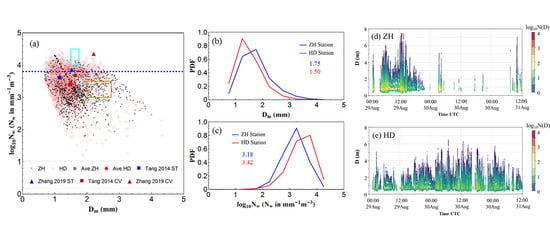Microphysical and Polarimetric Radar Signatures of an Epic Flood Event in Southern China
Abstract
1. Introduction
2. Data and Methodology
2.1. Data
2.2. Raindrop Size Distribution
2.3. Radar Quantitative Precipitation Estimation
3. Synoptic Environment during This Epic Rainfall Event
4. Precipitation Analysis Results and Discussion
4.1. Precipitation Pattern Observed by a Gauge Network
4.2. Raindrop Size Distribution
4.2.1. DSDs Time Series at Two Observation Stations
4.2.2. The Distribution of and
4.2.3. The DSD Spectra
4.3. Polarimetric Radar Signatures and Rainfall Analysis
4.3.1. The Polarimetric Radar Signatures
4.3.2. Radar-Based Quantitative Precipitation Estimation (QPE)
5. Discussion
6. Conclusions
Author Contributions
Funding
Acknowledgments
Conflicts of Interest
References
- Stevenson, S.N.; Schumacher, R.S. A 10-Year Survey of Extreme Rainfall Events in the Central and Eastern United States Using Gridded Multisensor Precipitation Analyses. Mon. Weather Rev. 2014, 142, 3147–3162. [Google Scholar] [CrossRef]
- Zhou, T.; Yu, R.; Chen, H.; Dai, A.; Pan, Y. Summer Precipitation Frequency, Intensity, and Diurnal Cycle over China: A Comparison of Satellite Data with Rain Gauge Observations. J. Clim. 2008, 21, 3997–4010. [Google Scholar] [CrossRef]
- Battan, L.J. Radar Observation of the Atmosphere; University of Chicago Press: Chicago, IL, USA, 1973. [Google Scholar]
- Abel, S.J.; Boutle, I.A. An improved representation of the raindrop size distribution for single-moment microphysics schemes. Quart. J. R. Meteor. Soc. 2012, 138, 2151–2162. [Google Scholar] [CrossRef]
- Tang, G.; Zeng, Z.; Ma, M.; Liu, R.; Wen, Y.; Hong, Y. Can Near-Real-Time Satellite Precipitation Products Capture Rainstorms and Guide Flood Warning for the 2016 Summer in South China? IEEE Geosci. Remote Sens. 2017, 14, 1208–1212. [Google Scholar] [CrossRef]
- Huang, Y.; Liu, Y.; Liu, Y.; Knievel, J.C. Budget Analyses of a Record-Breaking Rainfall Event in the Coastal Metropolitan City of Guangzhou, China. J. Geophys. Res. Atmos. 2019, 124, 9391–9406. [Google Scholar] [CrossRef]
- Li, H.; Wan, Q.; Peng, D.; Liu, X.; Xiao, H. Multiscale analysis of a record-breaking heavy rainfall event in Guangdong, China. Atmos. Res. 2020, 232, 104703. [Google Scholar] [CrossRef]
- Chen, X.; Zhao, K.; Xue, M. Spatial and temporal characteristics of warm season convection over Pearl River Delta region, China, based on 3 years of operational radar data. J. Geophys. Res. Atmos. 2014, 119, 412–447. [Google Scholar] [CrossRef]
- Fu, S.; Li, D.; Sun, J.; Si, D.; Ling, J.; Tian, F. A 31-year trend of the hourly precipitation over South China and the underlying mechanisms. Atmos. Sci. Lett. 2016, 17, 216–222. [Google Scholar] [CrossRef]
- Li, Z.; Yang, D.; Hong, Y. Multi-scale evaluation of high-resolution multi-sensor blended global precipitation products over the Yangtze River. J. Hydrol. 2013, 500, 157–169. [Google Scholar] [CrossRef]
- Ma, Y.; Zhang, Y.; Yang, D.; Farhan, S.B. Precipitation bias variability versus various gauges under different climatic conditions over the Third Pole Environment (TPE) region. Int. J. Climatol. 2015, 35, 1201–1211. [Google Scholar] [CrossRef]
- Wang, Z.; Zhong, R.; Lai, C.; Chen, J. Evaluation of the GPM IMERG satellite-based precipitation products and the hydrological utility. Atmos. Res. 2017, 196, 151–163. [Google Scholar] [CrossRef]
- Fulton, R.A.; Breidenbach, J.P.; Seo, D.; Miller, D.A.; O’Bannon, T. The WSR-88D Rainfall Algorithm. Weather Forecast 1998, 13, 377–395. [Google Scholar] [CrossRef]
- Bringi, V.N.; Chandrasekar, V. Polarimetric Doppler Weather Radar: Principles and Applications; Cambridge University Press: Cambridge, UK, 2001. [Google Scholar]
- Bechini, R.; Chandrasekar, V. A Semisupervised Robust Hydrometeor Classification Method for Dual-Polarization Radar Applications. J. Atmos. Ocean. Tech. 2015, 32, 22–47. [Google Scholar] [CrossRef]
- Park, H.S.; Ryzhkov, A.V.; Zrnić, D.S.; Kim, K. The Hydrometeor Classification Algorithm for the Polarimetric WSR-88D: Description and Application to an MCS. Weather Forecast 2009, 24, 730–748. [Google Scholar] [CrossRef]
- Wen, G.; Chen, H.; Zhang, G.; Sun, J. An Inverse Model for Raindrop Size Distribution Retrieval with Polarimetric Variables. Remote Sens. 2018, 10, 1179. [Google Scholar] [CrossRef]
- Sun, Y.; Xiao, H.; Yang, H.; Feng, L.; Chen, H.; Luo, L. An Inverse Mapping Table Method for Raindrop Size Distribution Parameters Retrieval Using X-band Dual-Polarization Radar Observations. IEEE Trans. Geosci. Remote Sens. 2020, 1–22. [Google Scholar] [CrossRef]
- Ryzhkov, A.V.; Giangrande, S.E.; Schuur, T.J. Rainfall Estimation with a Polarimetric Prototype of WSR-88D. J. Appl. Meteorol. 2005, 44, 502–515. [Google Scholar] [CrossRef]
- Berne, A.; Jaffrain, J.; Schleiss, M. Scaling analysis of the variability of the rain drop size distribution at small scale. Adv. Water Resour. 2012, 45, 2–12. [Google Scholar] [CrossRef]
- McFarquhar, G.M.; Hsieh, T.; Freer, M.; Mascio, J.; Jewett, B.F. The Characterization of Ice Hydrometeor Gamma Size Distributions as Volumes in N0–λ–μ Phase Space: Implications for Microphysical Process Modeling. J. Atmos. Sci. 2015, 72, 892–909. [Google Scholar] [CrossRef]
- Kalnay, E. The NCEP/NCAR Reanalysis 40-year Project. B. Am. Meteorol. Soc. 1996, 77, 437–471. [Google Scholar] [CrossRef]
- Tokay, A.; Wolff, D.B.; Petersen, W.A. Evaluation of the New Version of the Laser-Optical Disdrometer, OTT Parsivel2. J. Atmos. Ocean. Technol. 2014, 31, 1276–1288. [Google Scholar] [CrossRef]
- Löffler-Mang, M.; Joss, J. An Optical Disdrometer for Measuring Size and Velocity of Hydrometeors. J. Atmos. Ocean. Tech. 2000, 17, 130–139. [Google Scholar] [CrossRef]
- Ma, Y.; Ni, G.; Chandra, C.V.; Tian, F.; Chen, H. Statistical characteristics of raindrop size distribution during rainy seasons in the Beijing urban area and implications for radar rainfall estimation. Hydrol. Earth Syst. Sci. 2019, 23, 4153–4170. [Google Scholar] [CrossRef]
- Luo, L.; Xiao, H.; Yang, H.; Chen, H.; Guo, J.; Sun, Y.; Feng, L. Raindrop size distribution and microphysical characteristics of a great rainstorm in 2016 in Beijing, China. Atmos. Res. 2020, 239, 104895. [Google Scholar] [CrossRef]
- Janapati, J.; Seela, B.K.; Reddy, M.V.; Reddy, K.K.; Lin, P.; Rao, T.N.; Liu, C. A study on raindrop size distribution variability in before and after landfall precipitations of tropical cyclones observed over southern India. J. Atmos. Sol. Terr. Phys. 2017, 159, 23–40. [Google Scholar] [CrossRef]
- Seo, B.; Krajewski, W.F.; Quintero, F.; El Saadani, M.; Goska, R.; Cunha, L.K.; Dolan, B.; Wolff, D.B.; Smith, J.A.; Rutledge, S.A.; et al. Comprehensive Evaluation of the IFloodS Radar Rainfall Products for Hydrologic Applications. J. Hydrometeorol. 2018, 19, 1793–1813. [Google Scholar] [CrossRef]
- Atlas, D.; Srivastava, R.C.; Sekhon, R.S. Doppler radar characteristics of precipitation at vertical incidence. Rev. Geophys. 1973, 11, 1–35. [Google Scholar] [CrossRef]
- Jaffrain, J.; Berne, A. Experimental Quantification of the Sampling Uncertainty Associated with Measurements from PARSIVEL Disdrometers. J. Hydrometeorol. 2010, 12, 352–370. [Google Scholar] [CrossRef]
- Leinonen, J. High-level interface to T-matrix scattering calculations: Architecture, capabilities and limitations. Opt. Express 2014, 22, 1655. [Google Scholar] [CrossRef]
- Mackowski, D.W.; Mishchenko, M.I. A multiple sphere T-matrix Fortran code for use on parallel computer clusters. J. Quant. Spectrosc. Radiat. Transf. 2011, 112, 2182–2189. [Google Scholar] [CrossRef]
- Waterman, P.C. Matrix formulation of electromagnetic scattering. Proc. IEEE 1965, 53, 805–812. [Google Scholar] [CrossRef]
- Thurai, M.; Huang, G.J.; Bringi, V.N.; Randeu, W.L.; Schönhuber, M. Drop Shapes, Model Comparisons, and Calculations of Polarimetric Radar Parameters in Rain. J. Atmos. Ocean. Technol. 2007, 24, 1019–1032. [Google Scholar] [CrossRef]
- Jash, D.; Resmi, E.A.; Unnikrishnan, C.K.; Sumesh, R.K.; Sreekanth, T.S.; Sukumar, N.; Ramachandran, K.K. Variation in rain drop size distribution and rain integral parameters during southwest monsoon over a tropical station: An inter-comparison of disdrometer and Micro Rain Radar. Atmos. Res. 2019, 217, 24–36. [Google Scholar] [CrossRef]
- Xia, Q.; Zhang, W.; Chen, H.; Lee, W.-C.; Han, L.; Ma, Y.; Liu, X. Quantification of Precipitation Using Polarimetric Radar Measurements during Several Typhoon Events in Southern China. Remote Sens. 2020, 12, 2058. [Google Scholar] [CrossRef]
- Weisman, M.L.; Klemp, J.B.; Rotunno, R. Structure and Evolution of Numerically Simulated Squall Lines. J. Atmos. Sci. 1988, 45, 1990–2013. [Google Scholar] [CrossRef]
- Yang, L.; Smith, J.; Liu, M.; Baeck, M.L. Extreme rainfall from Hurricane Harvey (2017): Empirical intercomparisons of WRF simulations and polarimetric radar fields. Atmos. Res. 2019, 223, 114–131. [Google Scholar] [CrossRef]
- Powell, M.D. Changes in the low-level kinematic and thermodynamic structure of hurricane Alicia (1983) at landfall. Mon. Weather Rev. 1987, 115, 75–99. [Google Scholar] [CrossRef]
- Cifelli, R.; Chandrasekar, V.; Chen, H.; Johnson, L.E. High resolution radar quantitative precipitation estimation in the San Francisco Bay Area: Rainfall monitoring for the urban environment. J. Meteorol. Soc. Jpn. Ser. II 2018, 96A, 141–155. [Google Scholar] [CrossRef]
- Bringi, V.N.; Chandrasekar, V.; Hubbert, J.; Gorgucci, E.; Randeu, W.L.; Schoenhuber, M. Raindrop size distribution in different climatic regimes from disdrometer and dual-polarized radar analysis. J. Atmos. Sci. 2003, 60, 354–365. [Google Scholar] [CrossRef]
- Thompson, E.J.; Rutledge, S.A.; Dolan, B.; Thurai, M. Drop size distributions and radar observations of convective and stratiform rain over the equatorial Indian and West Pacific Oceans. J. Atmos. Sci. 2015, 72, 4091–4125. [Google Scholar] [CrossRef]
- Tang, Q.; Xiao, H.; Guo, C.; Feng, L. Characteristics of the raindrop size distributions and their retrieved polarimetric radar parameters in northern and southern China. Atmos. Res. 2014, 135–136, 59–75. [Google Scholar] [CrossRef]
- Chen, H.; Cifelli, R.; White, A. Improving operational radar rainfall estimates using profiler observations over complex terrain in Northern California. IEEE Trans. Geosci. Remote Sens. 2020, 58, 1821–1832. [Google Scholar] [CrossRef]
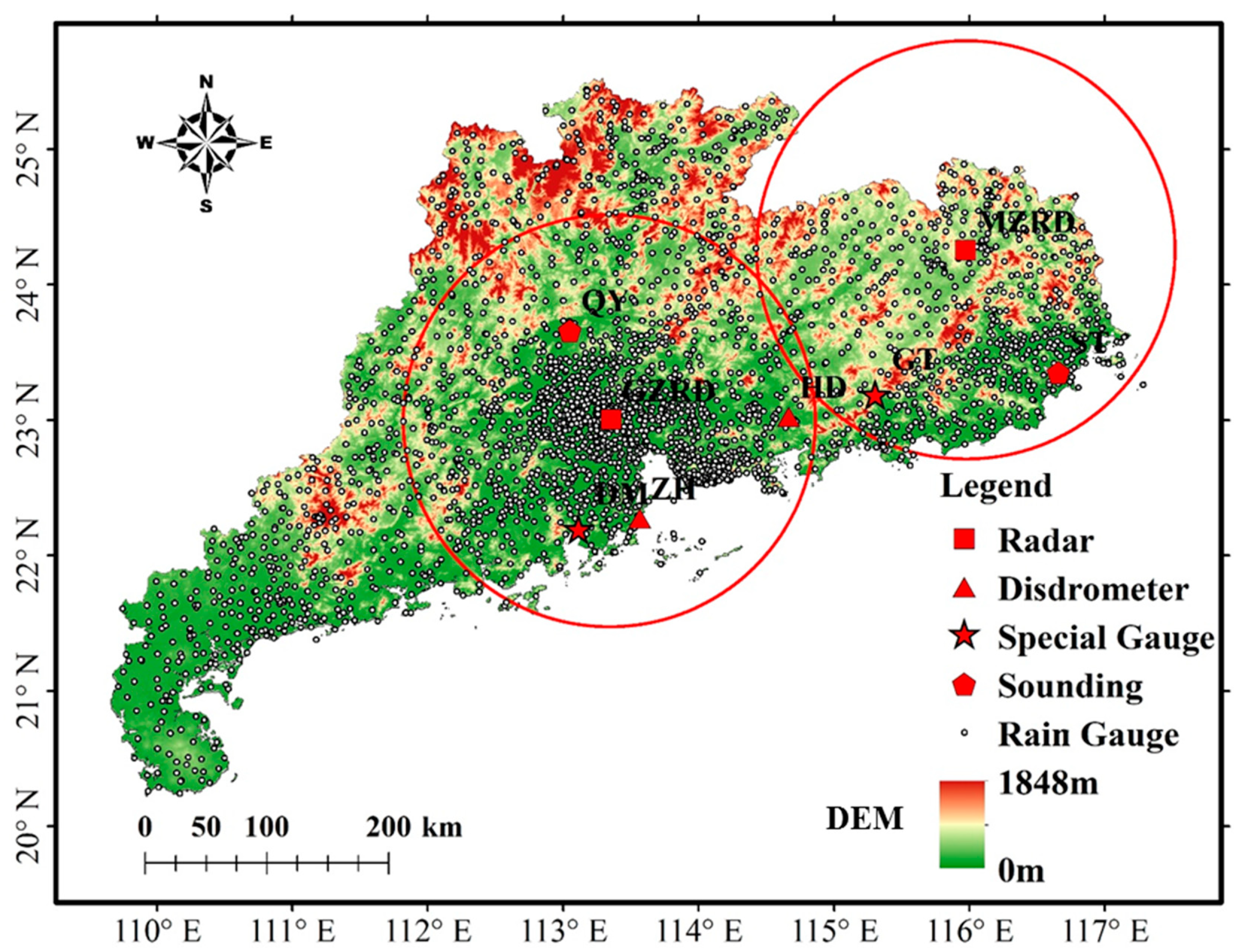
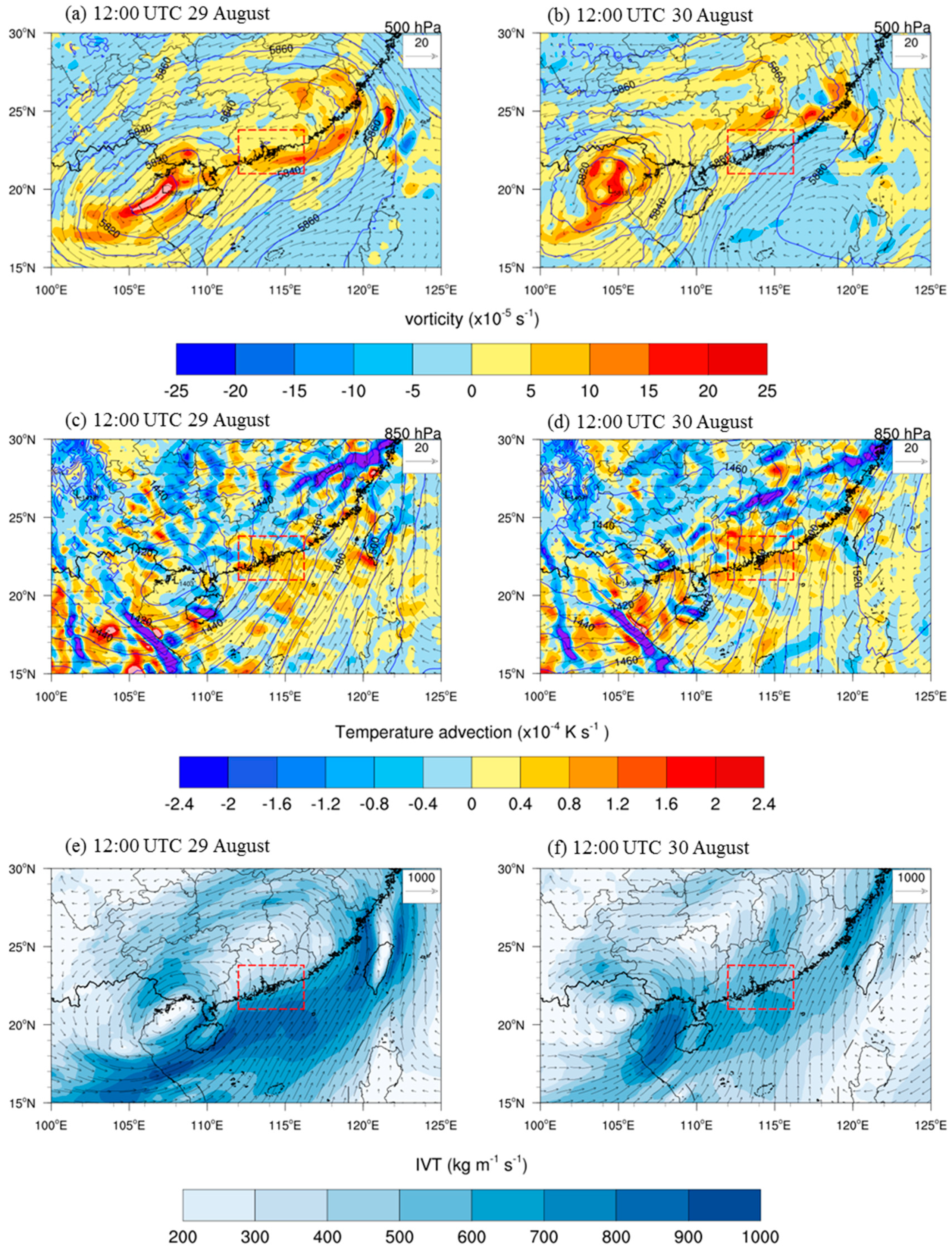
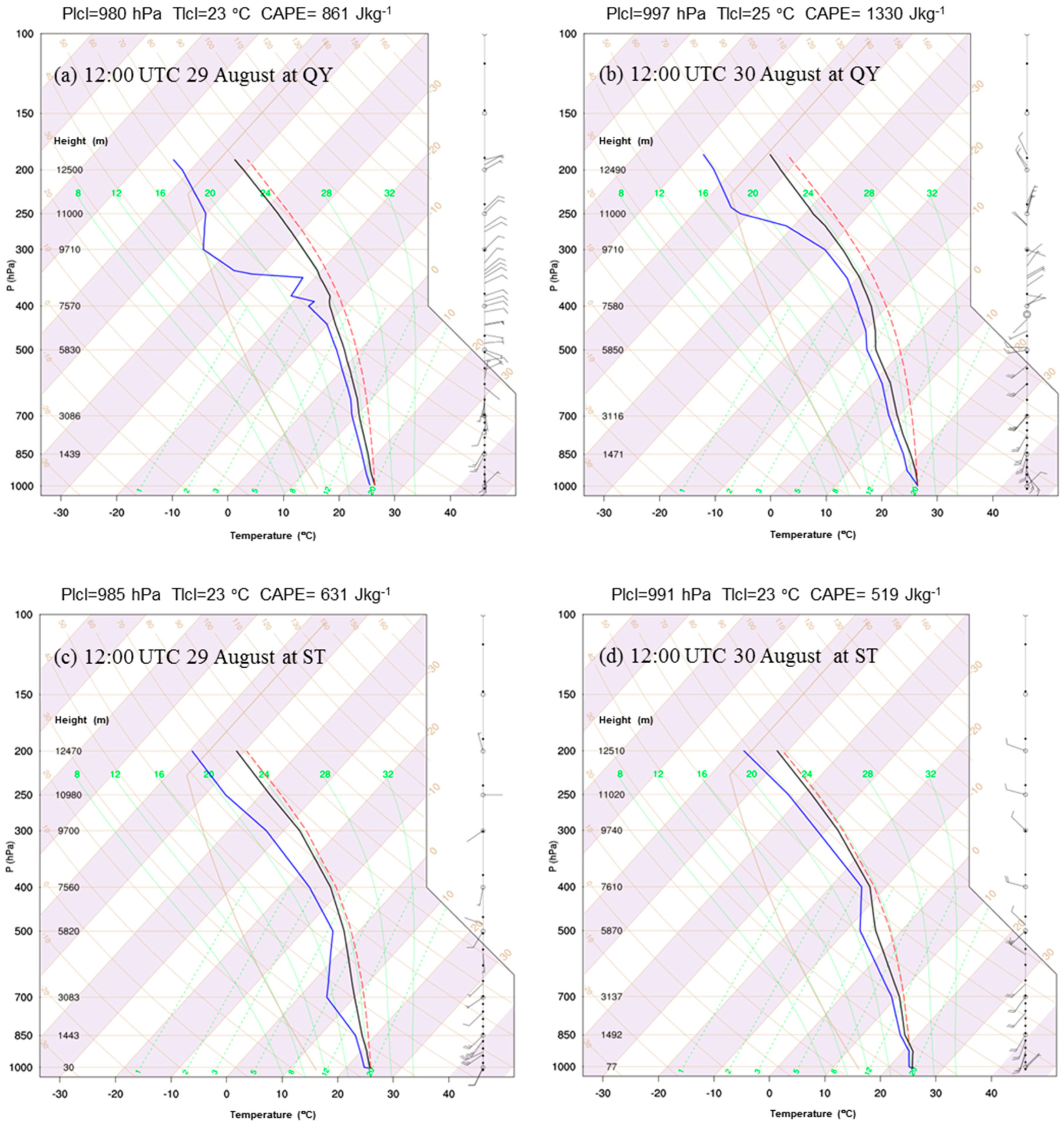
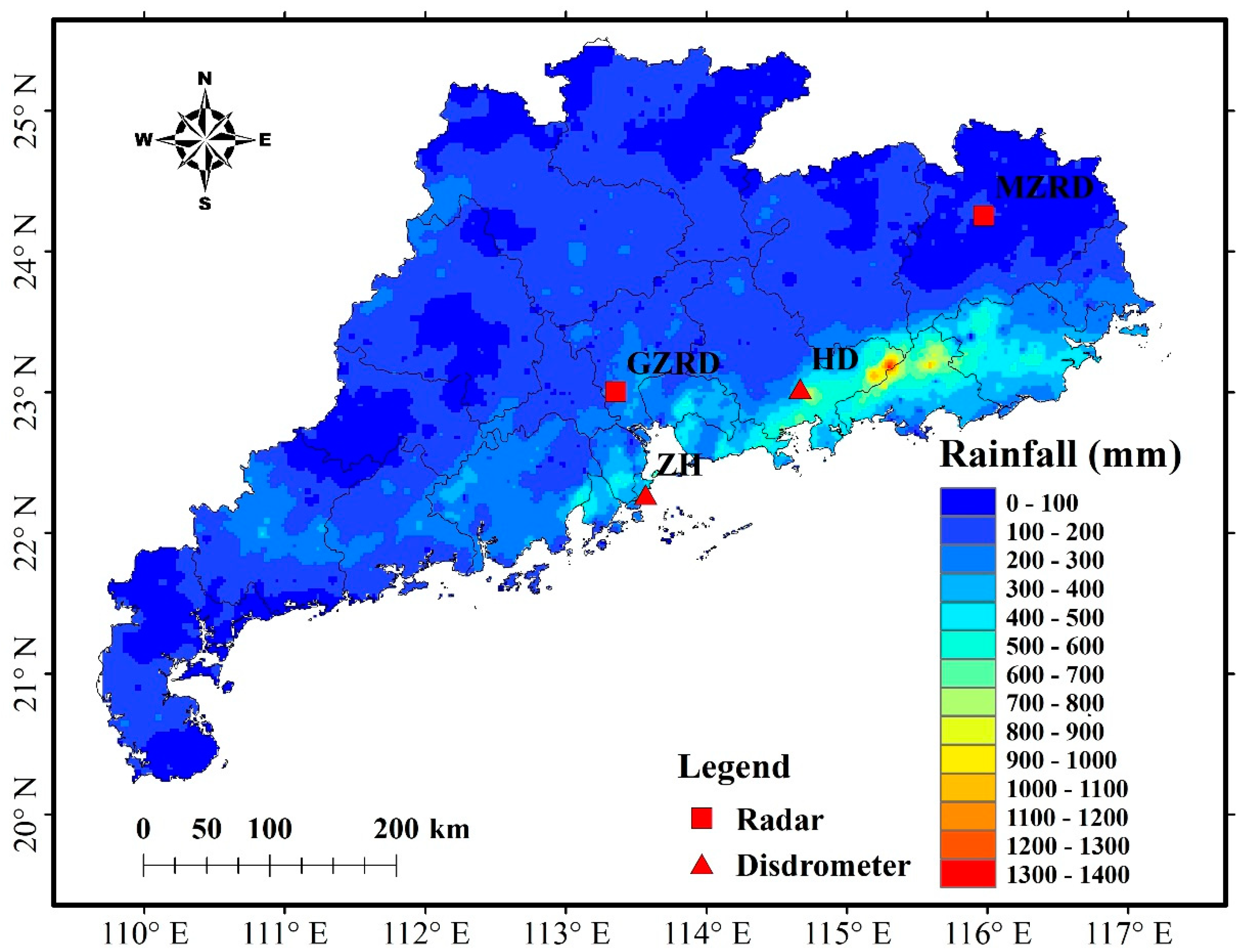
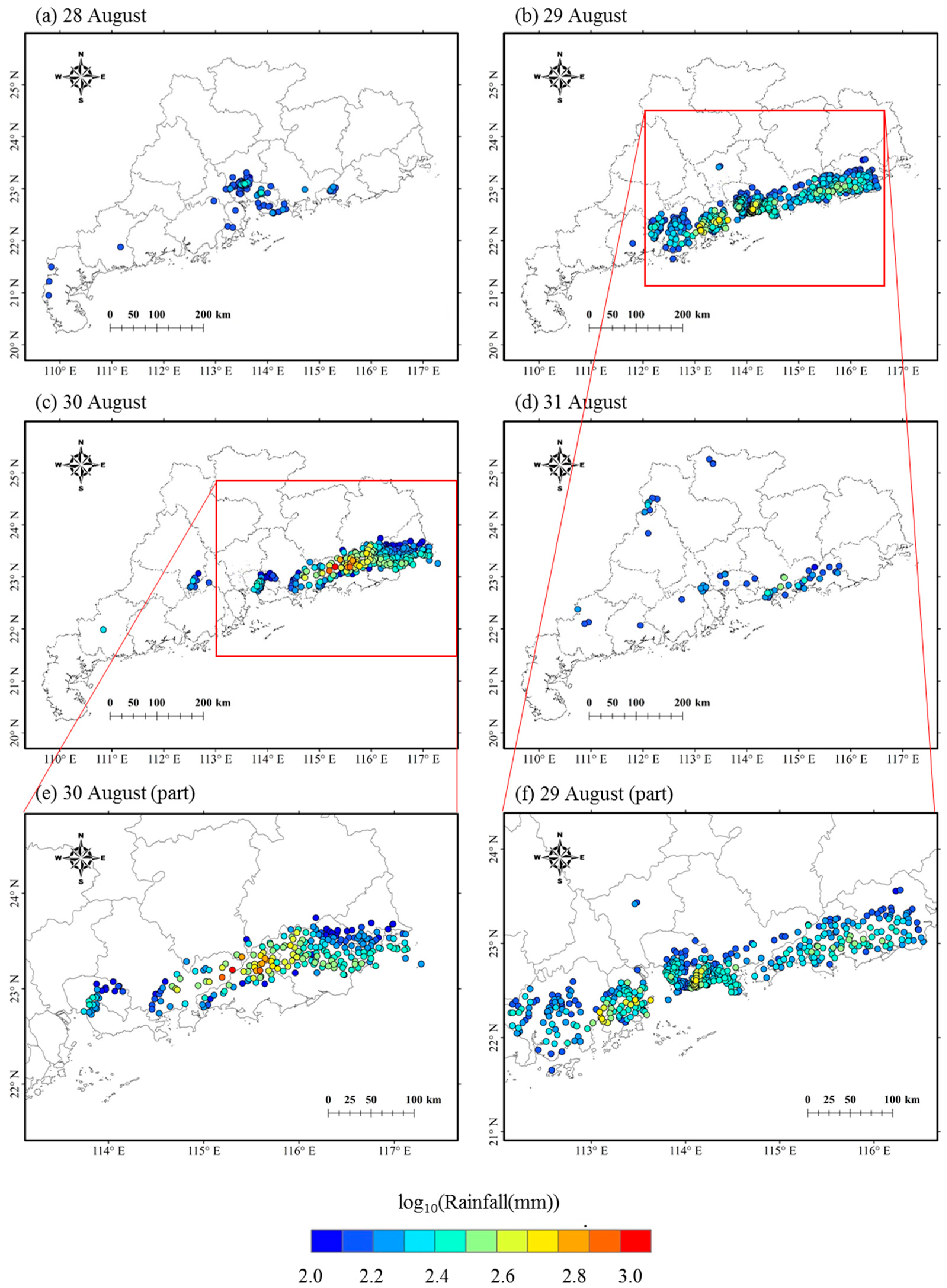
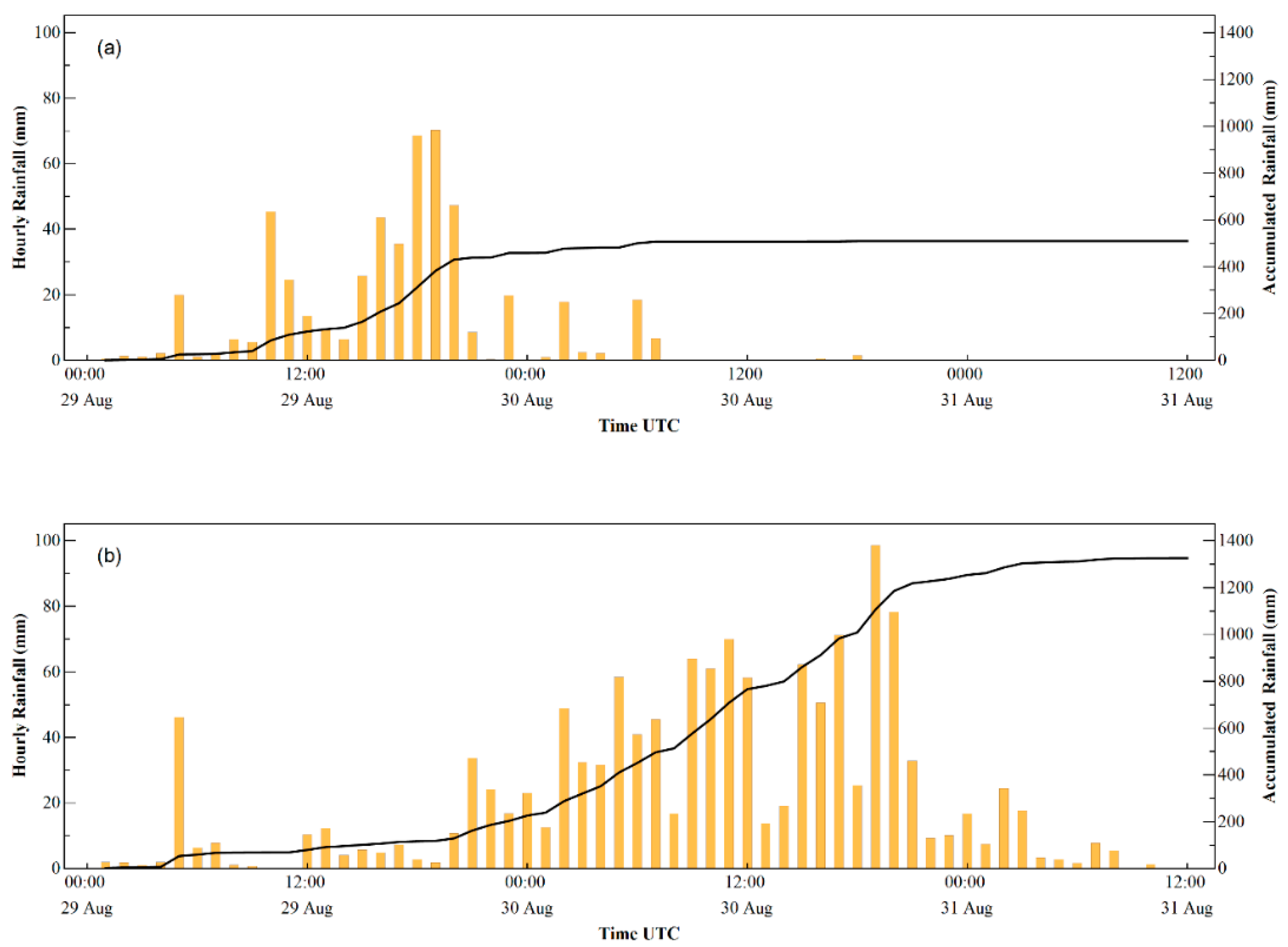
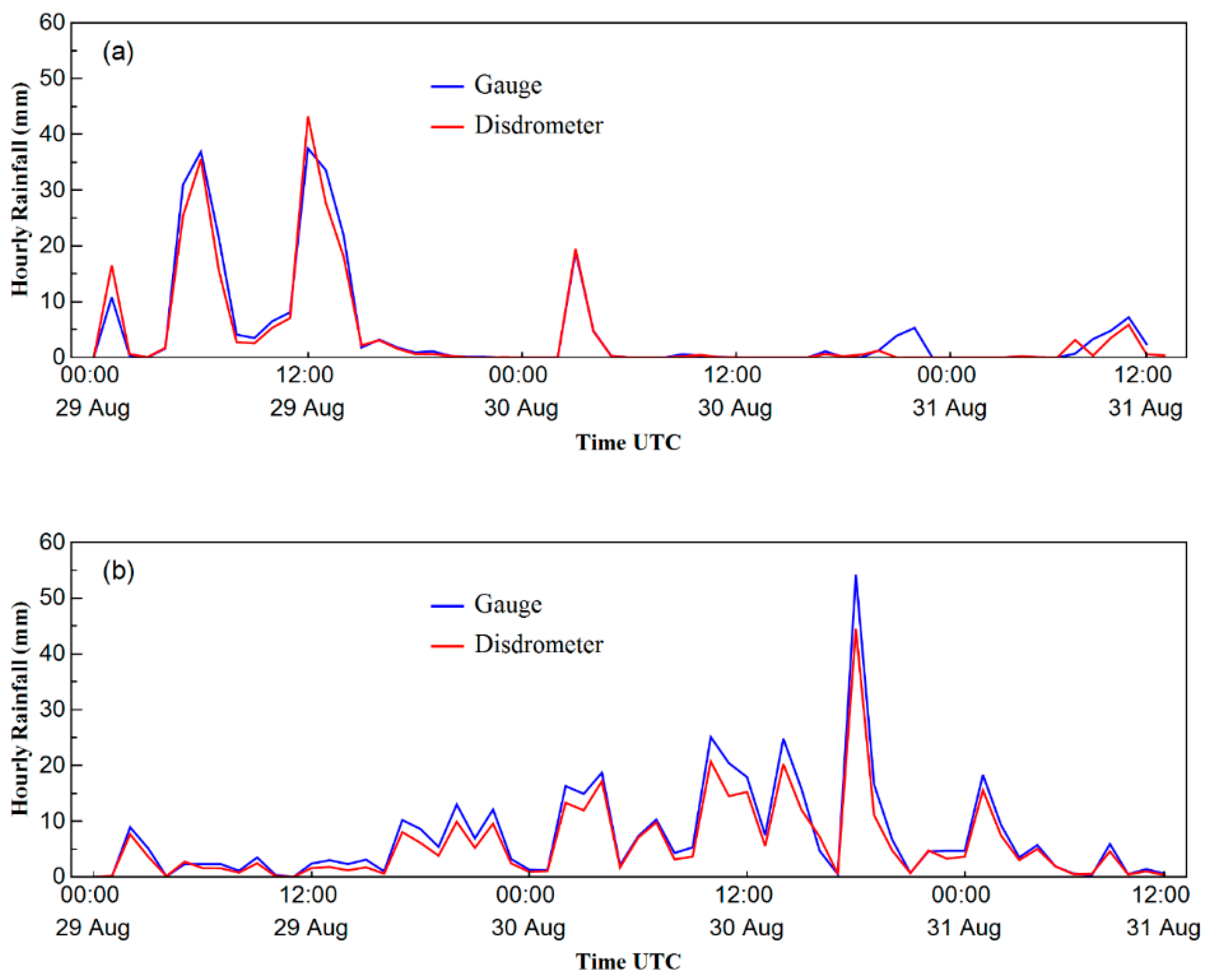
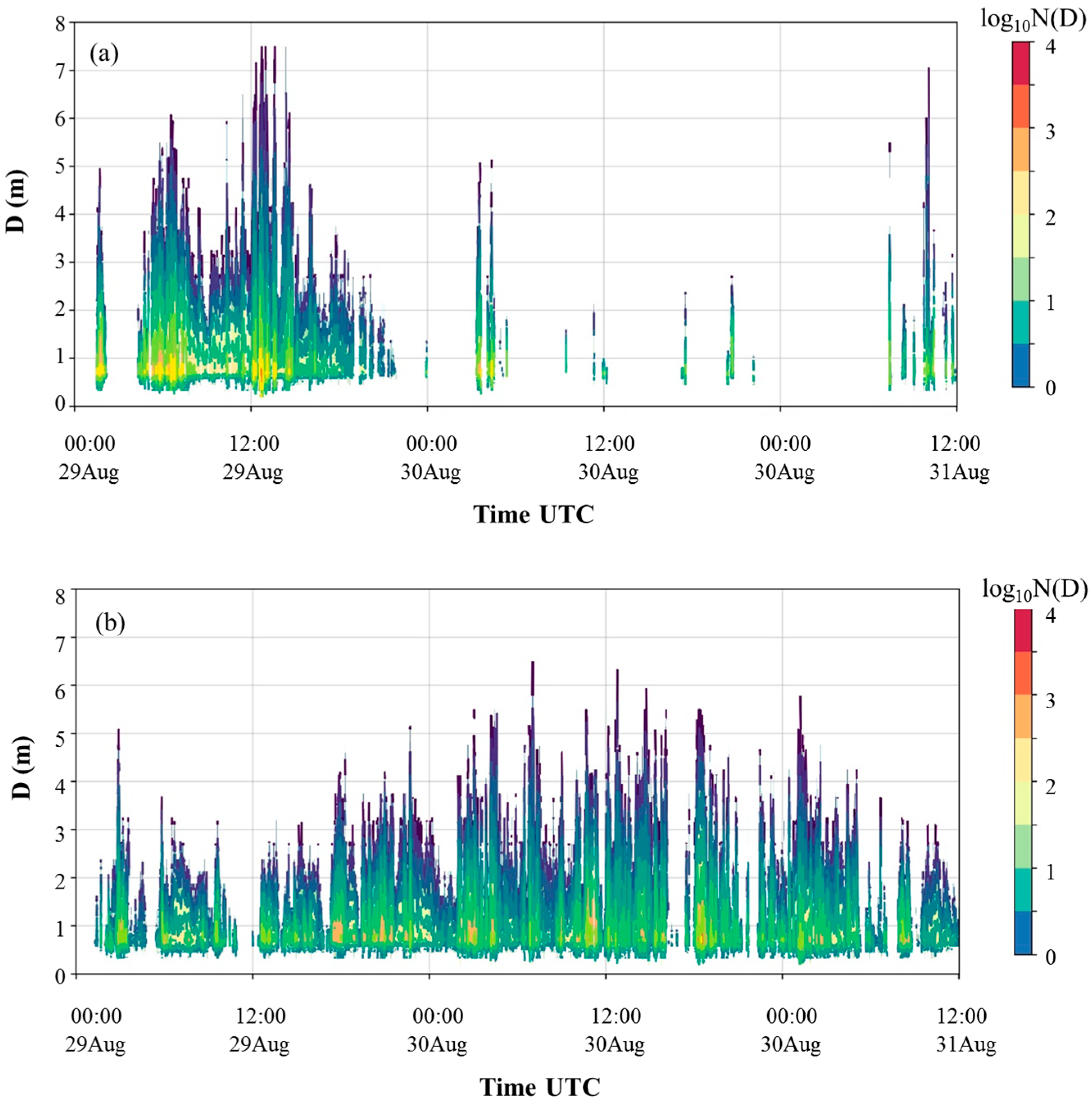
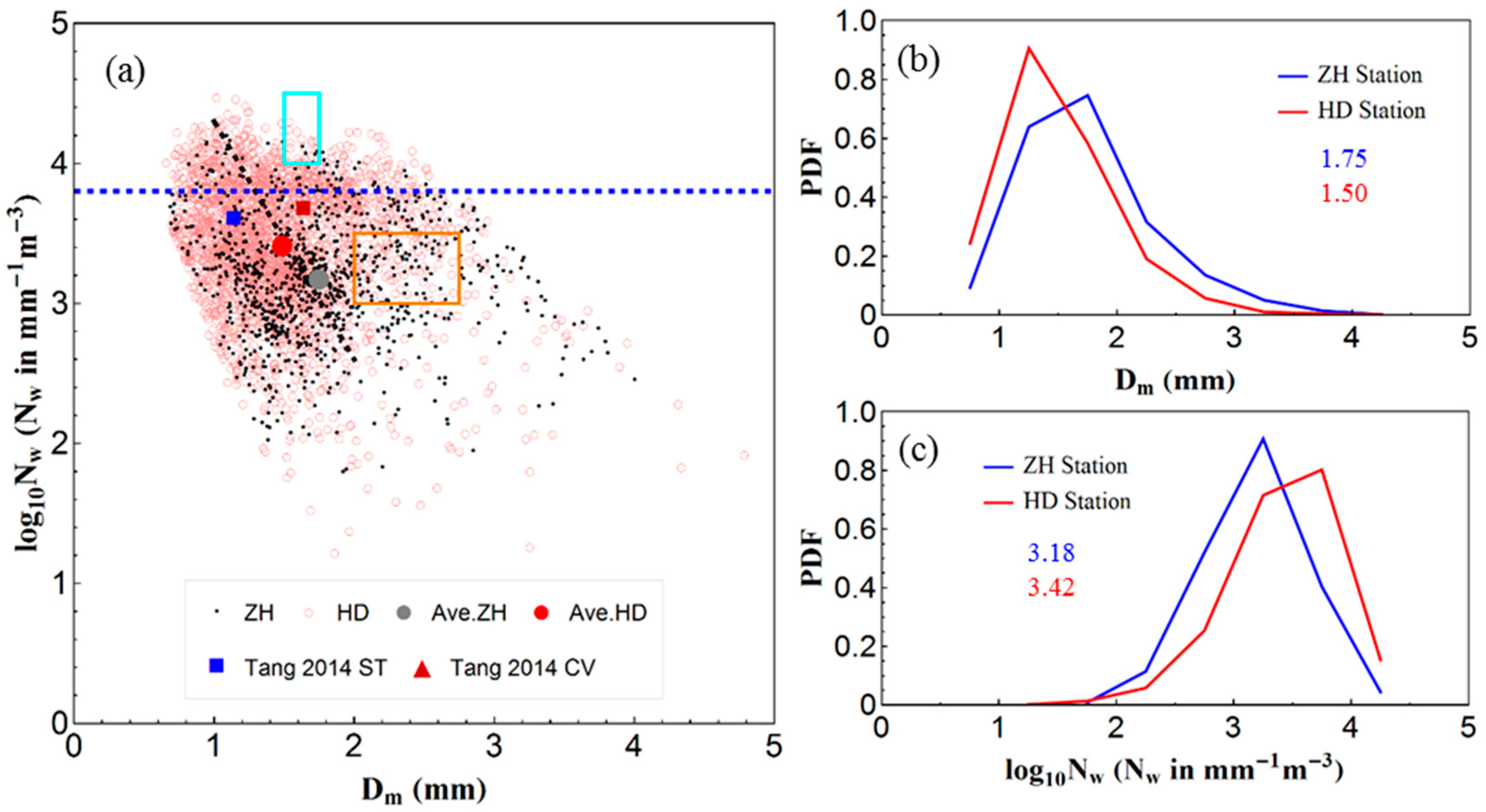
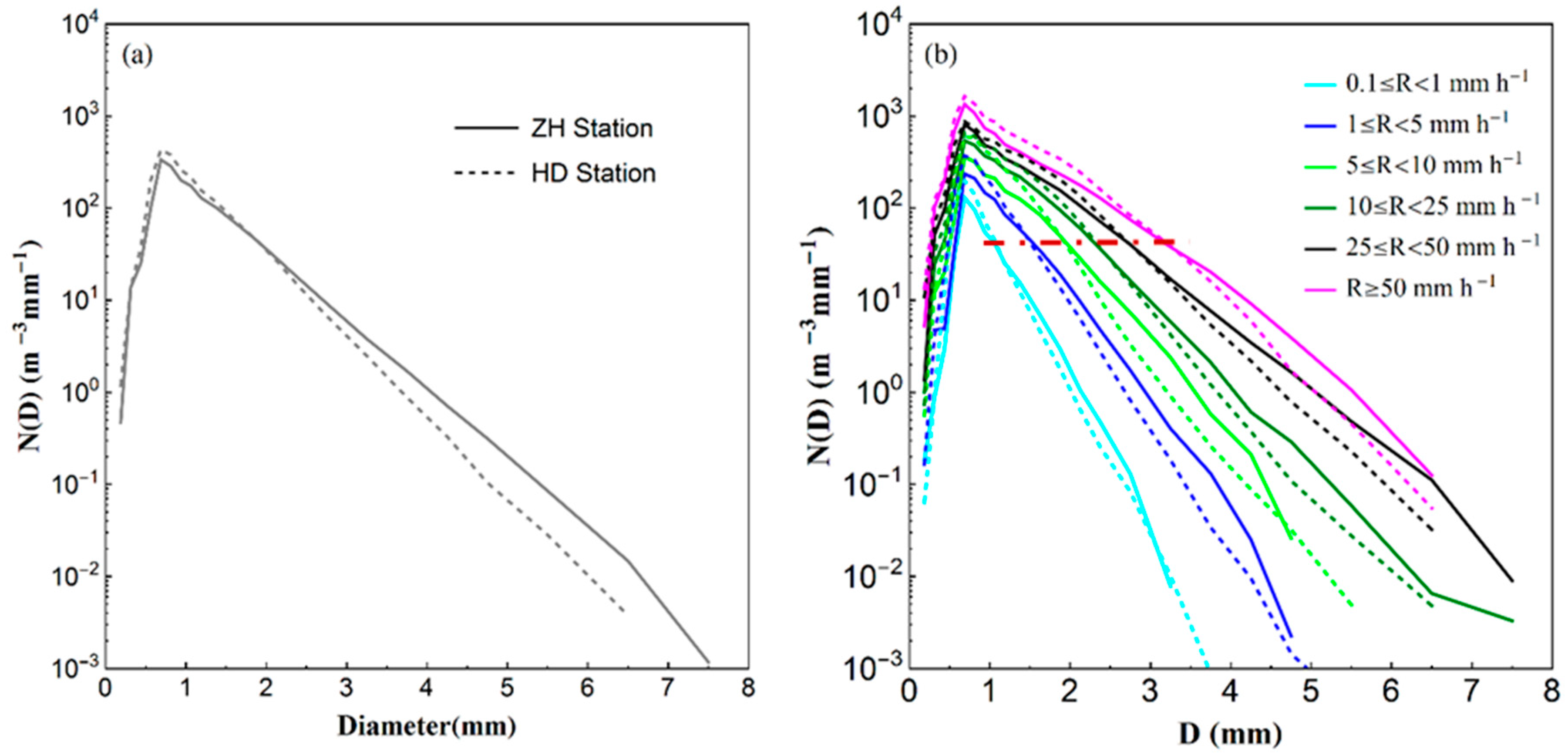
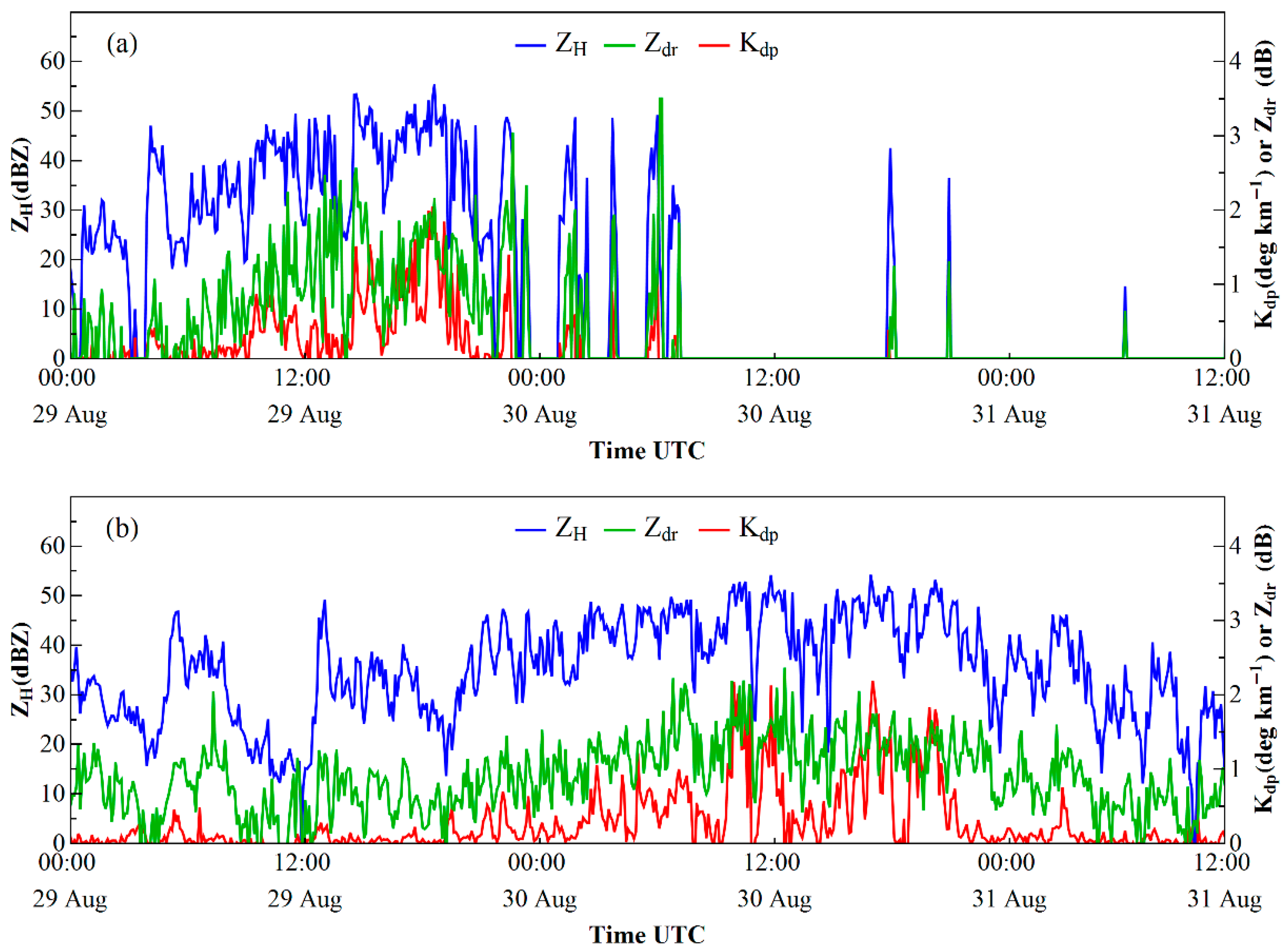
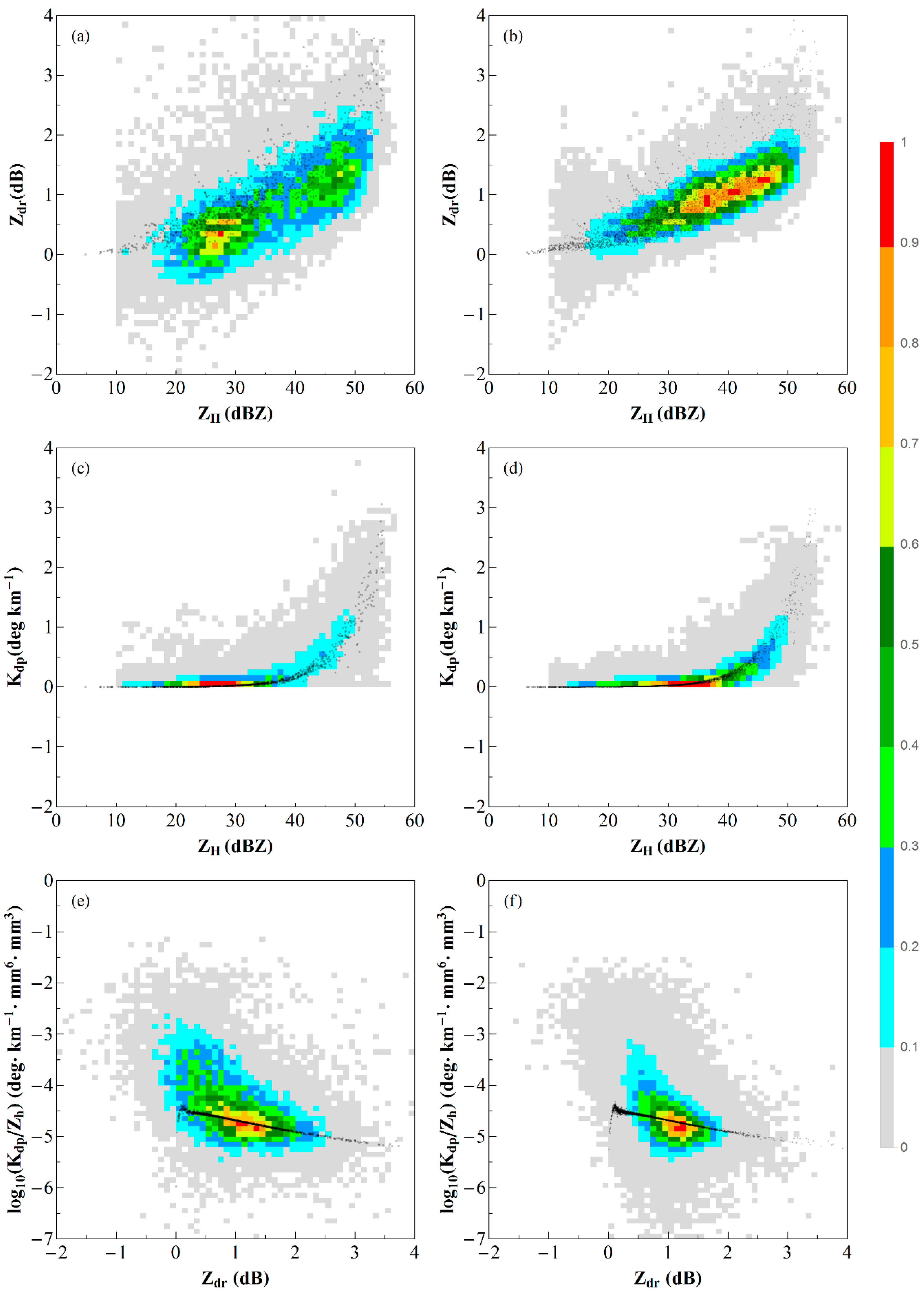
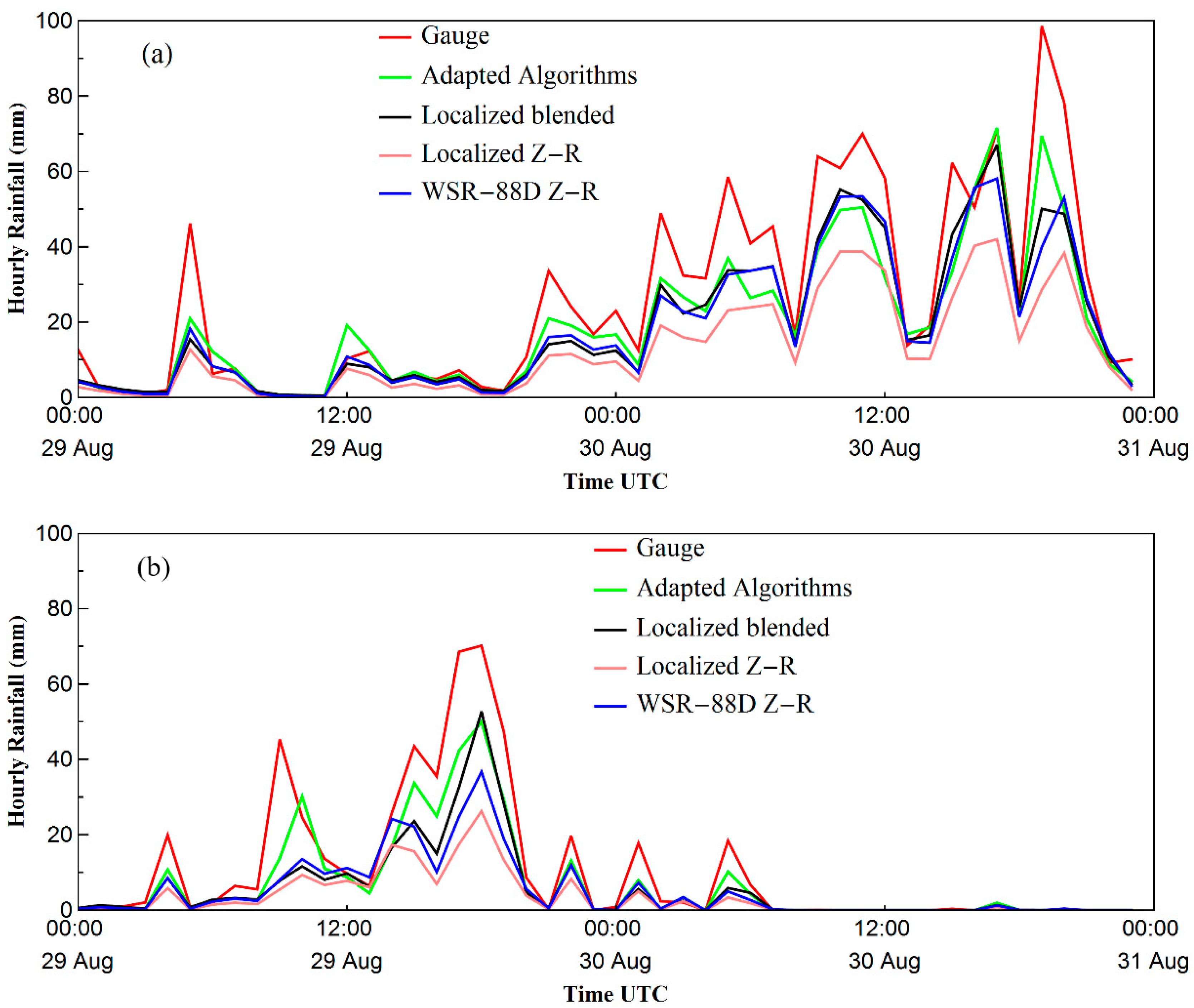
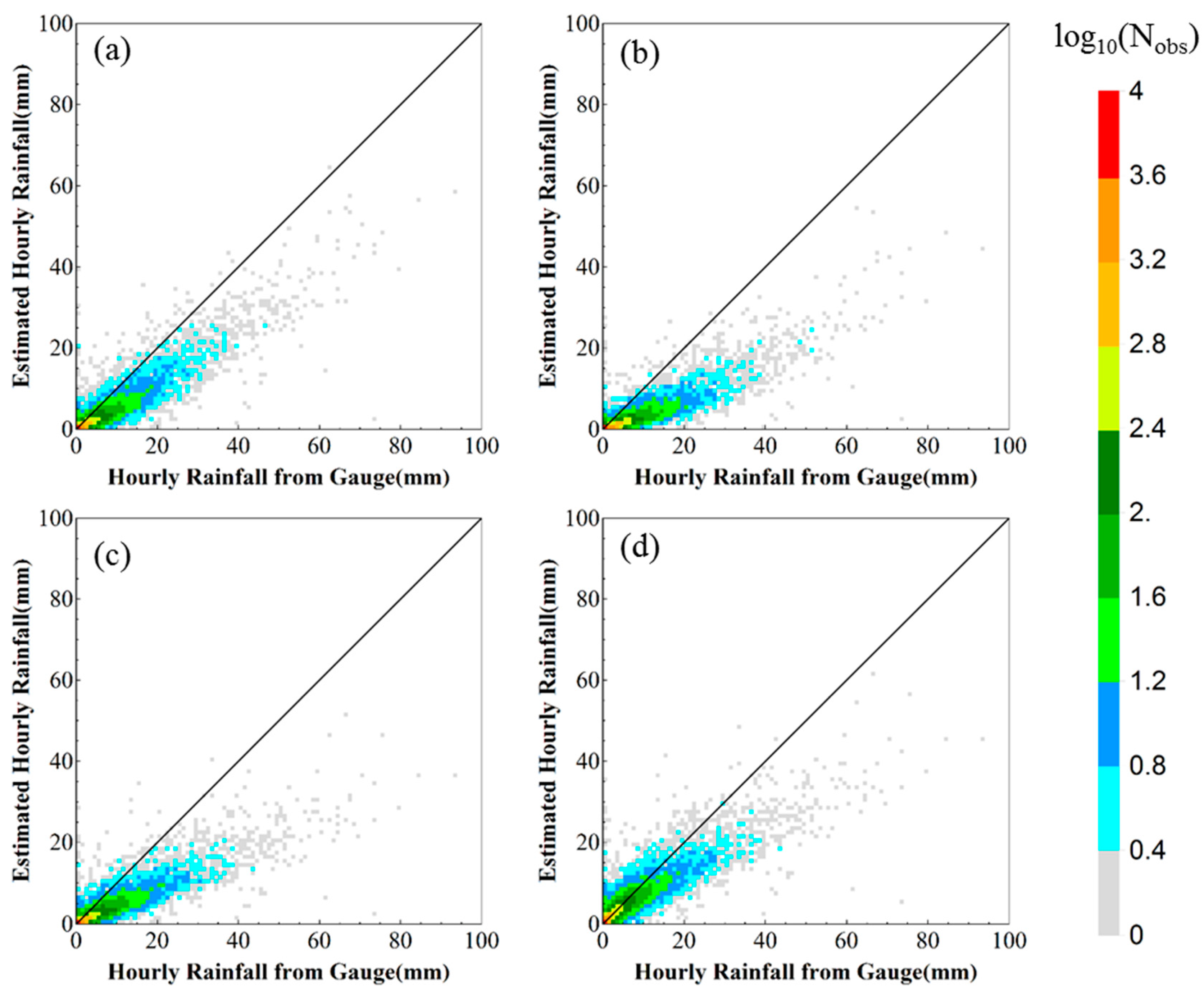
| Classes | Rain Rate Threshold (mm h−1) | Relative Frequency | Mean (mm h−1) | SD (mm h−1) | Skewness | ||||
|---|---|---|---|---|---|---|---|---|---|
| ZH | HD | ZH | HD | ZH | HD | ZH | HD | ||
| C1 | 0.32 | 0.32 | 0.52 | 0.48 | 0.25 | 0.26 | 0.05 | 0.27 | |
| C2 | 0.35 | 0.37 | 2.66 | 2.30 | 1.10 | 1.04 | 0.28 | 0.82 | |
| C3 | 0.09 | 0.11 | 7.41 | 7.07 | 1.45 | 1.44 | 0.17 | 0.32 | |
| C4 | 0.12 | 0.11 | 15.72 | 16.46 | 4.09 | 4.16 | 0.31 | 0.32 | |
| C5 | 0.09 | 0.06 | 35.41 | 35.38 | 6.85 | 7.30 | 0.25 | 0.34 | |
| C6 | 0.03 | 0.02 | 68.14 | 71.02 | 12.14 | 16.40 | 0.77 | 0.87 | |
| All data | - | 1 | 1 | 9.01 | 7.43 | 15.28 | 13.81 | 2.70 | 3.45 |
| Classes | (mm) | (m−3) | (m−3 mm−1) | (g m−3) | ||||
| ZH | HD | ZH | HD | ZH | HD | ZH | HD | |
| C1 | 1.29 | 1.14 | 54.8 | 81.0 | 2.94 | 3.18 | 0.030 | 0.031 |
| C2 | 1.66 | 1.43 | 139.6 | 200.5 | 3.19 | 3.42 | 0.132 | 0.127 |
| C3 | 1.96 | 1.64 | 255.2 | 409.6 | 3.30 | 3.67 | 0.337 | 0.360 |
| C4 | 2.18 | 1.96 | 429.8 | 548.5 | 3.44 | 3.66 | 0.682 | 0.748 |
| C5 | 2.62 | 2.32 | 648.2 | 786.8 | 3.44 | 3.66 | 1.409 | 1.474 |
| C6 | 2.80 | 2.48 | 1051.5 | 1369.3 | 3.57 | 3.82 | 2.616 | 2.863 |
| All data | 1.75 | 1.50 | 232.1 | 286.8 | 3.18 | 3.42 | 0.378 | 0.337 |
| D (mm) | (%) | (%) | (%) | (%) | ||||
|---|---|---|---|---|---|---|---|---|
| ZH | HD | ZH | HD | ZH | HD | ZH | HD | |
| <1 | 38.08 | 44.26 | 51.99 | 57.92 | 3.91 | 6.30 | 7.79 | 11.69 |
| 1~2 | 47.48 | 45.99 | 39.54 | 36.60 | 30.70 | 40.50 | 37.01 | 45.65 |
| 2~3 | 11.67 | 8.41 | 7.03 | 4.82 | 34.39 | 34.00 | 31.33 | 28.83 |
| 3~4 | 2.24 | 1.16 | 1.18 | 0.58 | 19.22 | 13.80 | 15.25 | 10.16 |
| >4 | 0.53 | 0.18 | 0.26 | 0.08 | 11.78 | 5.40 | 8.62 | 3.67 |
| Station | Metrics | Algorithm | |||
|---|---|---|---|---|---|
| “Adapted Algorithm” | Localized Blended Rainfall Algorithm | Localized Z–R Relation | WSR-88D Z-R Relation | ||
| Gaotan | BIAS (mm) | −6.61 | −7.30 | −13.17 | −7.90 |
| NMB (%) | −25.37 | −28.01 | −50.56 | −30.31 | |
| NMAE (%) | 29.64 | 30.16 | 50.56 | 32.26 | |
| CC | 0.95 | 0.94 | 0.93 | 0.93 | |
| Huidong | BIAS (mm) | −3.65 | −4.92 | −7.03 | −5.47 |
| NMB (%) | −34.39 | −46.37 | −66.29 | −51.63 | |
| NMAE (%) | 37.65 | 47.83 | 66.72 | 54.36 | |
| CC | 0.96 | 0.93 | 0.91 | 0.91 | |
| Metrics | Algorithm | |||
|---|---|---|---|---|
| “Adapted Algorithm” | Localized Blended Rainfall Algorithm | Localized Z–R Relation | WSR-88D Z-R Relation | |
| BIAS (mm) | −0.29 | −0.90 | −1.38 | −1.09 |
| NMB (%) | −12.47 | −39.21 | −60.35 | −47.70 |
| NMAE (%) | 39.93 | 46.38 | 63.24 | 53.76 |
| CC | 0.91 | 0.92 | 0.90 | 0.90 |
© 2020 by the authors. Licensee MDPI, Basel, Switzerland. This article is an open access article distributed under the terms and conditions of the Creative Commons Attribution (CC BY) license (http://creativecommons.org/licenses/by/4.0/).
Share and Cite
Ma, Y.; Chen, H.; Ni, G.; Chandrasekar, V.; Gou, Y.; Zhang, W. Microphysical and Polarimetric Radar Signatures of an Epic Flood Event in Southern China. Remote Sens. 2020, 12, 2772. https://doi.org/10.3390/rs12172772
Ma Y, Chen H, Ni G, Chandrasekar V, Gou Y, Zhang W. Microphysical and Polarimetric Radar Signatures of an Epic Flood Event in Southern China. Remote Sensing. 2020; 12(17):2772. https://doi.org/10.3390/rs12172772
Chicago/Turabian StyleMa, Yu, Haonan Chen, Guangheng Ni, V. Chandrasekar, Yabin Gou, and Wenjuan Zhang. 2020. "Microphysical and Polarimetric Radar Signatures of an Epic Flood Event in Southern China" Remote Sensing 12, no. 17: 2772. https://doi.org/10.3390/rs12172772
APA StyleMa, Y., Chen, H., Ni, G., Chandrasekar, V., Gou, Y., & Zhang, W. (2020). Microphysical and Polarimetric Radar Signatures of an Epic Flood Event in Southern China. Remote Sensing, 12(17), 2772. https://doi.org/10.3390/rs12172772






